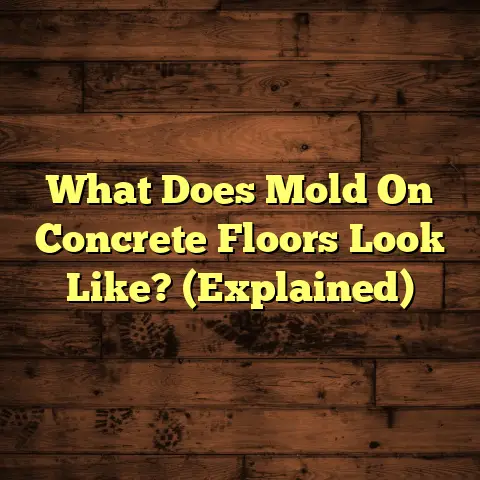Laminate Over Concrete Basement? (4 Issues Exposed!)
I’m going to dive deep into a topic that’s near and dear to my heart (and my business): laminate flooring in basements.
Laminate’s become super popular,
especially for those of us looking to
spruce up our basements without breaking
the bank.
It looks great, it’s relatively
easy to install, and the price is right.
But before you rush out and buy a
truckload of laminate, let’s pump the
brakes for a sec.
Basements are a whole
different ball game compared to your
living room or bedroom.
They have unique challenges, and if you don’t address them beforehand, your dream basement makeover could quickly turn into a soggy, warped nightmare.
I’ve seen it happen way too many times.
So, in this article, I’m going to expose four critical issues you need to be aware of before you even think about laying laminate over that concrete slab.
We’re talking moisture, subfloor prep, thermal insulation, and even sound.
Trust me, understanding these potential pitfalls can save you a ton of headaches, money, and heartache down the road.
Let’s get started!
1. Discussing Room-Specific Needs
1.1 Understanding the Basement Environment
Okay, let’s get real about basements.
They’re not your average room.
Think about it: they’re usually underground, surrounded by concrete, and often prone to dampness.
The biggest culprit?
Humidity.
Basements tend to be more humid than other parts of the house, especially during warmer months.
This is because concrete is porous and
can absorb moisture from the surrounding
soil.
That moisture then evaporates into
the air, raising the humidity levels.
And guess what loves humidity?
Mold and mildew!
Not to mention, high humidity can wreak havoc on your laminate flooring.
Another factor to consider is temperature fluctuations.
Basements can be significantly cooler than the rest of the house, especially in the winter.
This temperature difference can cause condensation, which is basically water forming on surfaces.
Again, not good for laminate.
Finally, let’s talk about water intrusion.
Even if your basement doesn’t flood regularly, it’s still susceptible to leaks from things like:
- Cracks in the foundation
- Poor drainage around the house
- Leaky pipes
All of these factors can create a challenging environment for flooring, especially laminate.
1.2 Identifying Usage Scenarios
Now, let’s think about how you plan to use your basement.
Are you envisioning a cozy family room where you can watch movies and play games?
Or maybe a home gym where you can sweat it out without disturbing the rest of the house?
Perhaps you’re planning a guest suite for visiting friends and family.
Or maybe it’s just going to be a storage space for all your holiday decorations and out-of-season clothes.
The intended use of the basement will significantly impact your flooring needs.
For example, if you’re planning a home gym, you’ll need flooring that’s durable enough to withstand heavy equipment and impact from dropped weights.
If you’re creating a family room, you’ll want something comfortable and inviting, maybe even sound-absorbent.
And if it’s a guest suite, you’ll want something that’s both aesthetically pleasing and easy to clean.
Here’s a quick rundown:
Think carefully about how you’ll be using the space before you make any flooring decisions.
1.3 Aesthetic Considerations
Okay, let’s talk about the fun stuff: how you want your basement to look.
One of the great things about laminate is that it comes in a huge variety of styles and colors.
You can find laminate that mimics the look of hardwood, tile, stone, and even concrete.
This makes it easy to achieve the aesthetic you’re going for without breaking the bank.
For example, if you want a warm and inviting space, you might choose a laminate that looks like hardwood with a natural finish.
If you’re going for a more modern look, you could opt for a laminate that looks like concrete or slate.
Color also plays a big role.
Lighter colors can make a basement feel brighter and more spacious, while darker colors can create a cozier and more intimate atmosphere.
Keep in mind that basements tend to be darker than other parts of the house, so you might want to choose a lighter color to help brighten things up.
Consider the existing elements in your basement, such as the wall color, furniture, and lighting.
Choose a laminate that complements these elements and helps to create a cohesive look.
1.4 Budget Constraints
Let’s face it: renovations can be expensive.
And flooring is often a significant chunk of the budget.
Laminate is generally considered to be an affordable flooring option, especially compared to hardwood or tile.
But even with laminate, costs can vary depending on the quality, style, and thickness of the material.
Don’t forget to factor in the cost of installation.
If you’re a DIYer, you can save money by installing the laminate yourself.
But if you’re not comfortable with DIY, you’ll need to hire a professional installer.
And that can add a significant amount to the overall cost.
Also, consider the cost of additional features like underlayment or moisture barriers.
These can add to the initial expense, but they can also save you money in the long run by protecting your flooring from moisture and extending its lifespan.
Pro Tip: Get multiple quotes from different flooring suppliers and installers to make sure you’re getting the best possible price.
2. Issue 1 – Moisture Control Challenges
2.1 The Importance of Moisture Management
Okay, let’s talk about the elephant in the basement: moisture.
As I mentioned earlier, basements are prone to moisture problems.
And moisture is the enemy of laminate flooring.
If moisture gets into your laminate, it can cause it to warp, swell, buckle, and even develop mold and mildew.
Not a pretty picture, right?
That’s why proper moisture management is absolutely crucial before you install laminate in your basement.
So, how do you know if you have a moisture problem in your basement?
Here are some telltale signs:
- Musty odor: This is a classic sign of mold and mildew.
- Visible water stains: Look for stains on the walls or floor.
- Efflorescence: This is a white, powdery substance that can form on concrete surfaces due to moisture.
- Condensation: Check for condensation on windows or pipes.
- Dampness: The floor or walls feel damp to the touch.
If you notice any of these signs, it’s important to address the moisture problem before you install your flooring.
Sources of moisture in a basement can include:
- Groundwater: Moisture seeping through the foundation walls or floor.
- Rainwater: Water entering through cracks in the foundation or around windows.
- Leaky pipes: Leaks in plumbing can introduce moisture into the basement.
- High humidity: As mentioned earlier, high humidity can lead to condensation.
2.2 Consequences of Poor Moisture Control
So, what happens if you ignore the moisture problem and install laminate anyway?
Well, let me tell you, it’s not going to be pretty.
Here are some of the consequences of poor moisture control:
- Warping: Laminate planks can warp and become uneven, creating an unsightly and uncomfortable surface.
- Swelling: Moisture can cause the laminate to swell, making it difficult to walk on and potentially damaging the flooring.
- Buckling: In severe cases, the laminate can buckle and lift off the subfloor.
- Mold and mildew: Moisture creates the perfect breeding ground for mold and mildew, which can cause health problems and damage your flooring.
- Delamination: The layers of the laminate flooring can separate, ruining the appearance and integrity of the floor.
I once had a client who ignored a small leak in their basement and installed laminate over it.
Within a few months, the laminate started to warp and swell.
Eventually, they had to rip out the entire floor and replace it.
It was a costly and time-consuming mistake that could have been avoided with proper moisture control.
2.3 Solutions and Precautions
Before you even think about installing laminate in your basement, you must assess the moisture levels.
This isn’t just a “nice to do,” it’s a “must do” to protect your investment.
Look for any signs of existing moisture problems, as I mentioned earlier.
If you suspect a moisture problem, it’s a good idea to hire a professional to conduct a moisture test.
They can use specialized equipment to measure the moisture levels in your concrete slab and determine the source of the problem.
Remember, I’m not giving solutions
here.
I’m just emphasizing the need
for proper moisture assessment.
Ignoring this step is like playing Russian roulette with your flooring.
3. Issue 2 – Subfloor Preparation Problems
3.1 The Role of the Subfloor
The subfloor is the foundation upon which your laminate flooring rests.
In a basement, this is typically a concrete slab.
The subfloor needs to be stable, level, and clean in order for the laminate to be installed properly.
If the subfloor is uneven, cracked, or dirty, it can cause problems with the laminate installation and affect its long-term performance.
Common issues with concrete subfloors include:
- Cracks: Concrete is prone to cracking, especially as it ages.
- Unevenness: The surface of the concrete may not be perfectly level.
- Debris: Dirt, dust, and other debris can accumulate on the concrete surface.
- Moisture: As we’ve already discussed, concrete can absorb moisture from the ground.
3.2 Impact on Installation
Improper subfloor preparation can lead to a number of problems during installation.
For example, if the subfloor is uneven, the laminate planks may not lie flat.
This can create gaps between the planks, which can be unsightly and can also allow moisture to seep in.
If the subfloor is cracked, the cracks can telegraph through the laminate, creating visible lines on the surface.
And if the subfloor is dirty, the dirt and debris can prevent the laminate from adhering properly.
This can lead to the laminate shifting or coming loose over time.
I’ve seen installations where people tried to cut corners on subfloor prep, and it always comes back to bite them.
Gaps, creaks, uneven surfaces – it’s a recipe for disaster.
3.3 Long-term Effects
Inadequate subfloor preparation can have long-term effects on the performance and longevity of your laminate flooring.
If the laminate is not properly supported, it can be more susceptible to damage from heavy traffic or dropped objects.
Moisture that seeps in through gaps or cracks can cause the laminate to warp, swell, or develop mold and mildew.
And if the laminate comes loose from the subfloor, it can create a tripping hazard.
All of these issues can lead to costly repairs and replacements down the road.
It’s much better to invest the time and effort in proper subfloor preparation upfront than to deal with these problems later on.
Think of it like this: your subfloor is the foundation of your flooring.
If the foundation is weak, the entire structure will be compromised.
4. Issue 3 – Thermal Insulation Concerns
4.1 Understanding Thermal Dynamics in Basements
Basements have a unique thermal profile compared to the rest of your house.
They’re typically cooler in the summer and colder in the winter.
This is because they’re surrounded by the earth, which acts as a natural insulator.
However, concrete itself is not a good insulator.
It conducts heat very well, which means that it can quickly absorb heat from the surrounding environment.
In the winter, this means that your concrete floor can feel very cold to the touch.
In the summer, it can help to keep the basement cool, but it can also lead to condensation if the humidity levels are high.
4.2 Laminate’s Thermal Properties
Laminate flooring is also affected by temperature changes.
Like most materials, laminate expands when it’s warm and contracts when it’s cold.
Some laminates are more resistant to temperature changes than others.
Thicker laminates tend to be more stable than thinner laminates.
And laminates with a moisture-resistant core are less likely to be affected by humidity.
4.3 Comfort Considerations
Thermal insulation is an important consideration, especially if you plan to use your basement as a living space.
A cold concrete floor can make the entire room feel uncomfortable, even if the air temperature is warm.
This is especially true if you plan to walk barefoot on the floor.
Think about how you’ll be using the space.
Will it be a cozy family room where you want to relax and watch movies?
Or will it be a home gym where you’ll be more focused on exercise than comfort?
If comfort is a priority, you’ll want to consider ways to improve the thermal insulation of your basement floor.
5. Issue 4 – Sound Transmission and Acoustics
5.1 The Sound Issue in Concrete Basements
Concrete is a dense, rigid material that reflects sound waves very well.
This means that sound can bounce around in a concrete basement, creating echoes and amplifying noise.
Laminate flooring can also contribute to this problem, as it is a hard, smooth surface that reflects sound.
Think about it: a bare concrete basement is like a giant echo chamber.
Every sound is amplified and reverberates throughout the space.
This can be particularly problematic if you have children, pets, or noisy appliances in the basement.
5.2 Potential for Echo and Noise
The acoustic properties of laminate flooring can contribute to unwanted noise levels in a basement setting.
Hard surfaces like laminate reflect sound waves, leading to increased reverberation and echo.
This can make it difficult to hear conversations or enjoy music or movies.
It can also create a sense of unease and discomfort, especially if the noise levels are high.
I’ve been in basements where you can hear every footstep, every dropped object, every word spoken.
It’s like living in a drum.
5.3 Impact on Usage
Sound issues can significantly impact the usability of your basement, especially if you plan to use it for entertainment or relaxation purposes.
If you’re trying to watch a movie in a noisy basement, the sound can be distracting and can make it difficult to follow the plot.
If you’re trying to relax and read a book, the echoes and reverberations can be annoying and can make it hard to concentrate.
And if you’re trying to have a conversation, the noise can make it difficult to hear what the other person is saying.
This is especially important to consider if you have neighbors who live above or next to your basement.
Noise from your basement can easily travel through the walls and floors, disturbing your neighbors and creating tension.
Conclusion
So, there you have it: four critical issues to consider before installing laminate flooring over a concrete basement.
We’ve covered moisture control, subfloor preparation, thermal insulation, and sound transmission.
These are all important factors that can affect the performance, longevity, and comfort of your flooring.
Remember, basements are unique environments that require careful planning and preparation.
Don’t rush into a flooring project without understanding the potential pitfalls.
Take the time to assess your basement’s specific needs and address any underlying issues before you start installing your laminate.
By doing so, you can avoid costly mistakes and create a beautiful, functional, and comfortable basement space that you’ll enjoy for years to come.
Good luck with your project!





